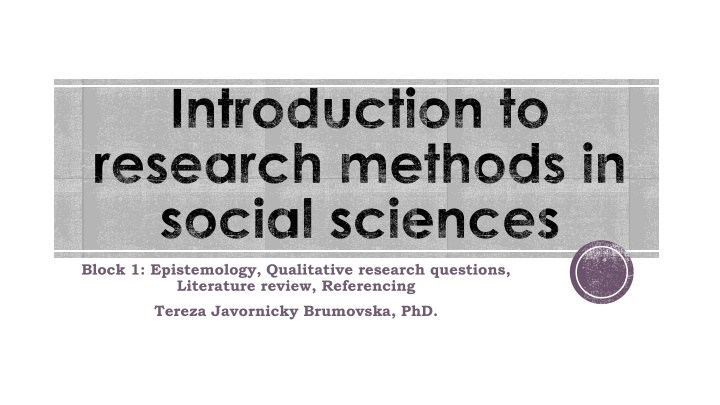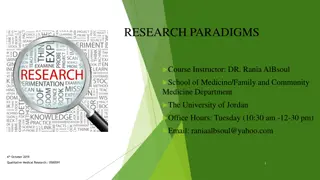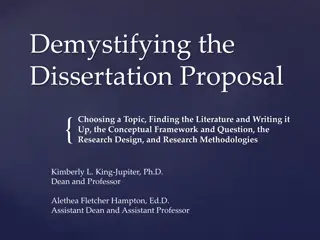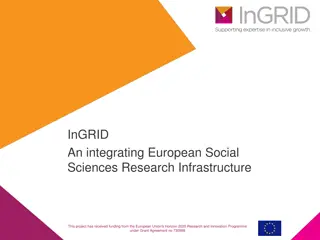Introduction to Epistemology in Social Sciences: Paradigms and Research Approaches
This content delves into the foundations of epistemology in social sciences, highlighting the evolution from positivism to constructivism and interpretivism. It explores the source of knowledge, development of knowledge, data interpretation, and research methodologies used in qualitative research.
Download Presentation

Please find below an Image/Link to download the presentation.
The content on the website is provided AS IS for your information and personal use only. It may not be sold, licensed, or shared on other websites without obtaining consent from the author.If you encounter any issues during the download, it is possible that the publisher has removed the file from their server.
You are allowed to download the files provided on this website for personal or commercial use, subject to the condition that they are used lawfully. All files are the property of their respective owners.
The content on the website is provided AS IS for your information and personal use only. It may not be sold, licensed, or shared on other websites without obtaining consent from the author.
E N D
Presentation Transcript
Introduction to research methods in social sciences Block 1: Epistemology, Qualitative research questions, Literature review, Referencing Tereza Javornicky Brumovska, PhD.
Process of research project Pre-fieldwork phase Field-work phase Data collection Analysis Conclusions, Reporting, Dissemination
Process of research project Block 1 Preparation of the field interesting topics, themes Literature review Research questions/aim and objectives Referencing Data management plan Ethics Gender in research Block 3 Searching for methodology and methods to address questions Fieldwork Analysis Writing, Reporting, Dissemination
Block 1: Outline Literature: Block 1: Punch: Chapter 1, 2, 3, 4 and 12, Part I Block 3: Punch: Chapter 8, 9, 10, 11 and 12, Part II Lecture 1: Introduction to research methodology and methods, epistemology and ontology in research Epistemological assumptions of qualitative research methodology in Social Sciences Lecture 2: Process of the research Stages of research project Literature review Research questions Referencing! Lecture 3: Writing the Research proposal Part I. = Your homework
Homeworks by 20thMarch 2021 Think of your theme/topic to explore in the research study / write the outline of the problem. Search and generate a list of related/relevant references to argue with in your project. Describe each of the reference briefly why is it relevant to your research topic of interest/aim and objectives/questions. Try to argue why the research questions are relevant in relation to your list of references. Download Zotero and try to explore it in terms of referencing: Use it in the text for references and then generate list of references in Harvard referencing style. Write a short report (500 words) on your experience to share next MS Teams meeting Think of aim and objectives related to your topic to explore Formulate 3 research questions
Epistemology in Research in Social Sciences Background of qual and quant approaches. Development from 1960s Paradigms in social sciences research: Positivism (quant) vs. Constructivism, Interpretivism and other approaches (Qual) Paradigm issues: What is the source of knowledge? Objective reality vs Subjective experience How is knowledge developed? Interpretation of data, Approach to respondents/participants/research subjects Autonomy/Authenticity of our datasource How are questions asked and answered? Induction vs. Deduction Qualitative research: is empirical research where the data are not in the form of numbers (Punch, 2005: 3). Language, visual data, arts-based data, participatory action results data etc.
Quantitative methodology: Qualitative methodlogy Deduction Inductive approach To test the hypothesis/previous research results/verify theory/conclusion previously made To develop new understanding/fill the gaps in knowledge/develop new explanation/theory/explore new phenomena Work with numbers with large amount or respondents/data Work with several respondents and large amount of data collected from them Statistical analysis methods Analysis of language/visuals/arts-based data Based on the objective data/objectivity of knowledge/positivist epistemology Subjectivity of experience considered as a relevant source of knowledge in exploring phenomena Epistemology of social constructivism/post- structuralism/Interpretivism etc.
Social sciences: Core and Appliedand research Core social sciences: Psychology, Sociology, Anthropology, Economics and Political Science Applied social sciences: Education, Social work, Children s Studies, Women s Studies, Family Studies, Health and Nursing, Social policy, Legal and justice studies (Can you think of other fields)? Interdisciplinarity in social sciences, across social and natural sciences Core social sciences Theory to observe as applied in the fields (e.g. Theory of Power in different social institutions, and agents behaviour, experiences, context) Develop new theory to explain social phenomena Test the theories Applied social sciences Research often to address praxis based on evidence, Evaluate quality of services Fill the gaps in theoretical knowledge on different phenomena Apply theories and research impact in praxis
Literature review What and why? WHAT: Sources of literature: Monographs Book chapters Peer-reviewed research articles Classical essays ? WHY? To argue your rationale for research questions: Build up an argument to your research questions/hypothesis -> Find out what to repeat to test the previous results/theory -> Find out the gaps in the literature/knowledge in the field of your interest -> Explain the research findings with the theory/previous results in discussion -> Generalise research findings with the theory that can explain your findings and turn them to results/conclusions and recommendations
Literature review where to look for literature Where do you look for the relevant literature to support your essays/writing/research? IMPORTANT: Use only peer-reviewed sources of literature no google blogs/random articles/wikipedia etc. unless it is well argued in its purpose as a data sample for the project! Previous BA thesis: It is good to see what other people wrote in terms of style and level of writing. However, it is questionable if to use it as a source for your literature review. Use it in Introduction. Consult with your supervisor. How to look for the literature: Databases: EBSCO, Jstore, PsychInfo what database you are using? Journals search through your favourite journal and related ones Publishing Houses: Taylor and Francis, Blackwell, Sage, Willey, Routledge, Springer, Elsevier Open access articles/journals: https://doaj.org (Directory of Open Access Journals DOAJ) Web of Science: Authors, Article title, DOI for particular articles Journals Impact Factor for relevance of references Key words in your search for articles record your search strategy Search list of references in your favourite articles Google Scholar is ok
Literature review cont. To have a deeper understanding of your topic of interest To see what was done/gaps in the literature in the topic of interest To build up your rationale for research aims and objectives/research questions To connect research aim and objectives/Questions with the methodology and methods To argue the methods of data collection e.g. questions/themes in interviews -> Essential part of your research project in the pre-fieldwork phase
Aims and Objectives, Research questions Qualitative research: Inductive Open-ended research questions Exploratory: To explore ..experiences of respondents with given phenomena Descriptive: Clear sheer description is often useful before interpretation of the data with theory and literature Rather OBJECTIVES than QUESTIONS: To explore (Experiences) of (SAMPLE, TARGET GROUP) with (PHENOMENA IN QUESTION) To address overall aim of the study Examples: How do students at our school spend their weekends? What is the effect of personal technology on today s youth? Vs. Explanatory: To explain relationships between different variables Hypothesis (Experiments) To observe the results of experiment while manipulating different dependent and independent variables in one particular chosen question/task/phenomena
Data and research questions Purely inductive approach in qual research Question to address the gaps in knowledge/literature Focus on the data that will be theorised/explained with formulation of theory that is missing Grounded theory: What are the needs of young girls in residential care? How these can be addressed by the services they use? Thematic analysis for description before interpretation using the language of respondents IPA Interpretive Phenomenological analysis: Questions experiences of respondents with given phenomena, what they have in common in their experiences E.g. What are children s perceptions of science and scientists? What are children s preferences in their choice of future profession? What impact on these decisions?
Theory and research questions Theory frames the research questions rationale Theory is used to explain and discuss research findings Content analysis E.g. What are the experiences of social support of youth in after-school services? What environmental factors help (RESEARCH SAMPLE) to cope with the COVID 19 public health measures? Why?
Referencing When/What to reference? To avoid plagiarism/To respect and acknowledge authors we build on To distinguish our ides from others before us/To build up argument with respected, peer-reviewed literature in the field In-text citations are used when directly quoting or paraphrasing a source. They are located in the body of the work and contain a fragment of the full citation. Harvard referencing/APA/ Chicago referencing etc. What style are you using? Guidelines for authors in journals check the referencing rules there Your referencing system is of your choice but has to be CONSISTENT and in line with one of the system you choose Use Zotero/EndNote/Mendeley/other referencing programme for the consistent referencing Consistent list of references in 1 click! Builds up your digital library of resources you re using in your field
Harvard referencing in text In-text citation Place this part right after the quote or reference to the source in your assignment. Template (Author Surname, Year Published) (Author, 3 authors or 1st author et al. if 4 and more authors) Authors divide by , Papers divided by ; No reference to first names Cite references after each argument/data/information you are using to argue your thesis/explanation of data/discussion etc.
Harvard referencing Journals Template: Journals Author Surname, Author Initial. (Year Published). Title. Publication Title, [online] Volume number(Issue number), p.Pages Used. Available at: http://Website URL [Accessed Date Accessed]. Example: Poynting, S. (2006). What caused the Cronulla riot?. Race&Class, 48(1), pp.85-92. Ross, N. (2015). On Truth Content and False Consciousness in Adorno s Aesthetic Theory. Philosophy Today, 59(2), pp. 269-290. Dismuke, C. and Egede, L. (2015). The Impact of Cognitive, Social and Physical Limitations on Income in Community Dwelling Adults With Chronic Medical and Mental Disorders. Global Journal of Health Science, 7(5), pp. 183-195.
Harvard referencing - Books Template: Book Author Surname, Author Initial. (Year Published). Title. ed. City: Publisher, p.Pages Used. Example: Pitt, C. and Smith, J. (2012). Pro PHP MVC. Berkeley, CA: Apress, pp.3-4.
Harvard referencing edited books Template: Book chapter in Edited book Author Surname, Author Initial. ed., (Year Published). Chapter Title. In: Title. [online] City: Publisher, p.Pages Used. Available at: http://Website URL [Accessed Date Accessed]. Example: Smith, J. ed., (2014). In: ABC, 1st ed. Melbourne: OUP, pp.24-63. Bressler, L. (2010). My girl, Kylie. In: L. Matheson, ed., The Dogs That We Love, 1st ed. Boston: Jacobson Ltd., pp. 78-92.
Referencing - Summary Very important to choose a Referencing style and use it consistent across your text Essential to reference every time you use someone else s ideas or information to avoid plagiarism and to build up your argument strongly References in-text are basically used in the same way for Journals, Books and Book chapters References on different sources of literature differ in the List of references. Consistency! For other less common sources of data (webpages, DVD, video, visual sources etc), please, look for the Harvard referencing guides online or text me for further direction. Do your own search inreferencing first. Your knowledge and practice of consistent use of references bring a professional level to your writing. On the other hand, mistakes in referencing are unnecessary and can be serious in terms of plagiarism! SO TAKE YOUR TIME AND FOCUS TO FAMILIARSE YOURSELF WELL WITH THE REFERENCING STYLE OF YOUR CHOICE AND USE IT CONSISTENTLY!
Ethics Research integrity Data protection: GDPR Anonymity Safe data storage, destruction of data after consented period of time Data management plan: Use of metadata in data repository for secondary analysis? FAIR Principles in DMP (Findable, Accessible, Interoperable, Reusable) www.re3data.org the handling of research data during and after the end of the project what data will be collected, processed and/or generated which methodology and standards will be applied whether data will be shared/made open access and how data will be curated and preserved (including after the end of the project). Consents of participants Right to withdraw from research any time for participants Information for minors in child-friendly manner
Data Management Plan, Open science FAIR Principle https://www.re3data.org/
Ethics including Gender in research
Introduction to Research Methods in Social Sciences Block II. (10.4.2021) Outline: Research designs in qualitative research (Chapter 8) Methods of data collection (Chapter 9) Methods of analysis (Chapter 9) Write-Up and Ethics (Chapter 12) (Short overview on applied social research, evaluation, mixed-methods designs) 1. 2. 3. 4. 5.
Homework check 1. Research questions Think of your theme/topic to explore in the research study / write the outline of the problem. 3. Referencing management Download Zotero and try to explore it in terms of referencing: Use it in the text for references and then generate list of references in Harvard referencing style. Write a short report (500 words) on your experience to share next MS Teams meeting Think of aim and objectives related to your topic to explore 2. Lit. review Search and generate a list of related/relevant references argue with in your project. Formulate 3 research questions Describe each of the reference briefly why is it relevant to your research topic of interest/aim and objectives/questions. Try to argue how the research questions are relevant in relation to your list of references
Block 4: Qualitative data collection and analysis
Block 4: Qualitative data collection and analysis Outline of the Block 4: 1. Research design: Case study Longitudinal design Explorative design 2. Sampling 3. Data collection Interviews Structured COFFEE BREAK Semi-structured Unstructured COFFEE BREAK 4. Data analysis -Thematic analysis - IPA COFFEE BREAK 5. Write-Up and Ethics 6. Final essay to close the course, your comments and questions END OF THE BLOCK 4
Research design: Case study Focus on the single case or few ideal cases Track the given question an ideal showcase In-depth qualitative analysis from various perspectives on one case Can include multiple method of analysis: Interviews, documentary analysis, discourse analysis -> following the research aim and objectives Single case -> Shows one phenomena from different perspectives More cases in case study design comparison of one aspect between more cases
Research design: Longitudinal study Tracking the same group of research respondents (Research sample) for more than 1 time over the period of time Often in psychology, sociology To track the developmental processes in the given question To track changes in various aspects following the research question Valuable sources of data highly valued in research field esp. in psychology
Research design: Explorative study Exploration a question or a phenomena in focus that hasn t been exlplored in depth before Based on the identified gaps in the literature addresses a good lit. review with identified gaps that justify the research rationale. Exploration is INDUCTIVE looks at something we don t have much knowledge about to date.
Sampling Purposive sampling: - Based on the aim and objectives of the study. - Defines the group to explore that has an experience/something in research aim and objective in common - E.g. Teenagers with experience of xx, patients of xx with experience of health care (other given phenomena), LGB T plus members attitudes to romantic relationships, participants of cult on their experinece with their membership in the cult group etc .. Snowball sampling: - Respondents recommended to the researcher from the social networks of the previous respondents
Data collection methods Interviews Observation Discourse analysis Participatory methods
Interviews Focus groups group interviews Structured Semi-structured Unstructured
Structured interviews Quantitative research designs Heavily structured Based in theory deductive Detailed questions, not much space for the interviewee s narrative, experience, expression To test a theory Asking strictly same questions in the same order to all participants (many) for clear comparison in given focus/factors E.g. BDTJ Batery of diagnistic language tests (Development of Psychological psychotests in language skills in children)
Semi-Structured interviews Partly structured based on: Questions, Themes, Literature gaps themes Vary in the level of structure and level of the space for the research respondent provided for their expression Questions the more questions, the more structure and less authentic experience is derived from the interview Themes you have your own structure based on the knowledge of literature. Leaving the respondent to talk and listening to the themes that are being covered -> Rich data describing one s subjective experiences with the given phenomena. Less leading, more authentic. More work in analysis Meaning of the data and the order is seeked in analysis. Excellent knowledge of the literature review is needed for less structured interviews to make it meaningful as a result of the process Interpretation of meaning based on your literature/background philosophy/approach to the data need to be acknowledged in the Methods chapter.
!!! S. Kvale: InterViews !!! Phenomenological approach to interviewing Kvale views the interview as facilitating empathetic access to the world of the interviewee (Kvale, 1996: 125). the sequence of themes to be covered about the explored experience as well as suggested questions. At the same time, there is an openness to changes of sequence and forms of questions in order to follow up the answers given and the stories told by the subject. (Kvale,1996:124) The themes of interviews can be focused on exploring the experiences and understanding, attitudes, perceptions, stereotypes, and other subjectivities Perception/Experiences of different roles, stages in life/relationships/experience dynamics, characteristics of given phenomena in the experience of the respondent (mentoring relationships) in different context/setting e.g. mentoring relationships, experience of health care in AIDS patients, experience of protest leaders in elderly movement in Ireland etc.).
10 Points of Good InterView YouTube videos on how to do a good/avoid bad interviews, e.g. https://www.youtube.com/watch?v=9t_hYjAKww&ab_channel=GrahamRGibbs S. Kvale (1996): InterViews (Your Bible of good in-depth Interviewing) 10 Points of good InterView Introduction of the interview: Welcome the respondent, say what is the interview about and introduce ethical consideration for the respondent Keep eye-contact, try to build a rapport with the respondent, don t just read your questions unpersonally Don t just accept short questions but do some prompts, follow up questions to get more details e.g. Can you tell me more about this? What is (enjoyable) for you about it? Can you give me an example when it is enjoyable? Don t ask 2 questions in one time Further investigate long pause in Interviewee .might be thinking about details ask about it . Don t change the topics too quickly, try to explore the topic with details Don t ask leading questions Don t ask questions that only offer yes or no answers (Is it stressful?) but rather WHY, How (is it stressful) etc. Explore! 1. 2. 3. 4. 5. 6. 7. 8.
Cont Maintain a good FLOW in the interview Make an interviewee et ease, make them feel well in your presence so they feel good, engaged and animated to share their feelings, experiences, information, thoughts with you Introduction: To the interview, purpose of the interview, how long it should last Ethical issues: Stop whenever they want, take a break, doesn t have to respond if they don t want to, use of the data info Rapport is important: Eye contact, listen actively to what the interviewee is saying Ask probe questions to detail the answers Summarise what was said, ask for clarifications and use the summary to introduce the new question. You can give an interviewee an idea and little time to think about the next question At the end: Summarise what was said briefly and give a chance to the interviewee to clarify or add on anything else
Unstructured Interviews Narrative methods Tom Wengraf: BNIM Biographic-Narrative Interviewing Method SQUIN: Single question at Inducing Narrative
Analysis in Qual Research Basic principles Iterative analytical rounds/Hermeneutics Inductive or deductive = theory-driven Inductive = Based on data, in-depth analysis and conclusions, generalisation with relevant theory or theory that is constructed based on the findings Thematic analysis Content analysis = used to quant counts to the qualitative coding. Often in quantitative research designs. Interpretive Phenomenological Analysis
Saldaa (2013): Qualitative research coding: Basic terms in qual. Analysis process Codes: A word or short phase that symbolically assigns a summative salient, essence-capturing and/or evocative attribute for a portion of language-based or visual data A descriptor of a data segment that assigns meaning (Seal, 2016) Coding: Not just labelling but linking = it leads you from the data to the idea and from the idea to the data pertaining to that idea Linking codes = finding patterns. Patterns are links in the data that tell us something significant about the research question . Allow us to develop THEMES Themes: Theoretical construct supported by the data. A theme reflects a significance of the pattern within the data in relation to the research question (Seal,2016). Theoretical construct, that explains similarities or variations across codes (Ibid). An abstract entity that brings meaning and identity to a recurrent patterned experience and its variant manifestation. As such, a theme captures and unifies the nature or basis of the experience into a meaningful whole (DeSantis and Ugurizza) Theme develops from codes via the categories Categories To get from the codes to the themes, categories help to narrow down and identify the patterns. Codes grouping the data under the same topic. More abstract and conceptualised than codes Sub-categories codes grouped under the same category = topic Analytical memos: Important to write down during the process of analysis! To have a track record of what you have done for your Methodology chapter/part of your report/article. Very good practice!
DESCRIPTOR OF A DATA SEGMENT THAT ASSIGNS MEANING CODE CATEGORY Derived from codes, more conceptual and abstract THEME Theoretical construct that explains similarities, patters or variations across codes
Examples of codes, categories, sub-categories - Exercise I: How are you doing in Corona online teaching? Teacher: It is very demanding mode of teaching, different concentration and it is going for too long these days, everyone involved is close to a burn-out and I am starting to give up too. We all need holidays at this stage of the year (Laugh) Open codes: Categories: Subcategories: Themes:
I: How are you doing in Corona online teaching? Teacher: It is very demanding mode of teaching, different concentration and it is going for too long these days, everyone involved is close to a burn-out and I am starting to give up too. We all need holidays at this stage of the year (Laugh) Open codes: Red, green and blue Red: Demanding Green: Different teaching Blue: Feeling exhausted Categories: Teaching environment 1. Personal experience of online teaching 2. Theme: Online teaching experience
Types of codes Descriptive codes: Different teaching In Vivo codes: Burn-out, Demanding, Give-up etc . Emotion codes: Feeling exhausted. Interpretation of the underlying feelings that captures the in-vivo codes Try this explaning youtube video: https://www.youtube.com/watch?v=YP3yAX5w6x8&ab_channel=NicoleKipar
Thematic analysis Braun and Clarke, 2006 Involves searching for and identification of themes. A theme: . . . captures something important about the data in relation to the research question and represents some level of patterned response or meaning within the data set. . . .Furthermore, the keyness of a theme is not necessarily dependent on quantifiable measures but in terms of whether it captures something important in relation to the overall research question . Thematic analysis can adopt two distinctive forms. Inductive: Exploratory research seeking detailed descriptions of the entire datasets without specific theoretical or empirical research questions may use an inductive analysis that allows for the emergence of the key themes across the whole dataset, thus, giving the audience a comprehensive overview of all the recurrent themes occurring in the data. Theory-driven TA: tends to be much more focused on specific aspect(s) of the dataset guided by the researchers theoretical interests, while paying less attention to themes unrelated to the research question in the overall dataset.























